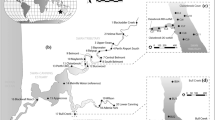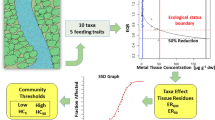Abstract
Recent years have seen considerable improvement in water quality standards (QS) for metals by taking account of the effect of local water chemistry conditions on their bioavailability. We describe preliminary efforts to further refine water quality standards, by taking account of the composition of the local ecological community (the ultimate protection objective) in addition to bioavailability. Relevance of QS to the local ecological community is critical as it is important to minimise instances where quality classification using QS does not reconcile with a quality classification based on an assessment of the composition of the local ecology (e.g. using benthic macroinvertebrate quality assessment metrics such as River InVertebrate Prediction and Classification System (RIVPACS)), particularly where ecology is assessed to be at good or better status, whilst chemical quality is determined to be failing relevant standards. The alternative approach outlined here describes a method to derive a site-specific species sensitivity distribution (SSD) based on the ecological community which is expected to be present at the site in the absence of anthropogenic pressures (reference conditions). The method combines a conventional laboratory ecotoxicity dataset normalised for bioavailability with field measurements of the response of benthic macroinvertebrate abundance to chemical exposure. Site-specific QSref are then derived from the 5%ile of this SSD. Using this method, site QSref have been derived for zinc in an area impacted by historic mining activities. Application of QSref can result in greater agreement between chemical and ecological metrics of environmental quality compared with the use of either conventional (QScon) or bioavailability-based QS (QSbio). In addition to zinc, the approach is likely to be applicable to other metals and possibly other types of chemical stressors (e.g. pesticides). However, the methodology for deriving site-specific targets requires additional development and validation before they can be robustly applied during surface water classification.

Similar content being viewed by others
References
Beltman D, Clements W, Lipton J, Cacela D (1999) Benthic invertebrate metals exposure, accumulation and community-level effects downstream from a hard-rock mine site. Environ Toxicol Chem 18:299–307
Bossuyt BTA, Janssen CR (2005) Multigeneration acclimation of Daphnia magna Straus to different bioavailable copper concentrations. Ecotoxicol Environ Saf 61:327–336
Brix K, De Forest D, Adams W (2011) The sensitivity of aquatic insects to divalent metals: a comparative analysis of laboratory and field data. Sci Total Environ 409:4187–4197
Buchwalter D, Cain D, Clements W, Luoma S (2007) Using biodynamic models to reconcile differences between laboratory toxicity tests and field biomonitoring with aquatic insects. Environ Sci Technol 41:4821–4828
Carlisle D, Clements W (1999) Sensitivity and variability of metrics used in biological assessments of running waters. Environ Toxicol Chem 18:285–291
Clark RT, Davy-Bowker J, Murphy J, Furse MT (2004) RIVPACS III+ (Great Britain) user manual. Centre for Ecology and Hydrology, Dorchester
Clarke RT, Furse MT, Davy-Bowker J, Clarke RT, Furse MT, Davy-Bowker J (2003a) Analysis of 1995 survey data: phase 1 post-survey appraisal. Unit I: changes in biological condition. R&D Technical Report E103. Environment Agency, Bristol
Clarke RT, Wright JF, Furse MT (2003b) RIVPACS models for predicting the expected macroinvertebrate fauna and assessing the ecological quality of rivers. Ecol Model 160:219–233
Clarke R, Davy-Bowker J, Sandin L, Friberg N, Johnson R, Bis B (2006) Estimates of comparisons of the effects of sampling variation using “national” macroinvertebrate sampling protocols on the precision of metrics used to assess ecological status. Hydrobiologia 566:477–503
Crane M, Maltby L (1991) The lethal and sublethal responses of Gammarus pulex to stress: sensitivity and variation in an in-situ assay. Environ Toxicol Chem 10:1331–1339
ECB (2003) Technical Guidance Document on risk assessment in support of Commission Directive 93/67/EEC on risk assessment for new notified substances, Commission Regulation (EC) No 1488/94 on risk assessment for existing substances, Directive 98/8/EC of the European parliament and the Council concerning the placing of biocidal products on the market. Part II. European Commission Joint Research Centre, Ispra
Environment Agency (2009a) Ecological indicators for abandoned mines, phase 1: review of the literature. SC030136-49/SR. Environment Agency, Bristol
Environment Agency (2009b) Using biotic ligand models to help implement environmental quality standards for metals under the Water Framework Directive. Science Report–SC080021/SR7b. Environment Agency, Bristol
Environment Agency (2011) Method statement for the classification on surface water bodies v2.0 (external release). Environment Agency, Bristol
Esbaugh AJ, Brix KV, Mager EM, de Schamphelaere K, Grosell M (2012) Multi-linear regression analysis, preliminary biotic ligand modelling, and cross species comparison of the effects of water chemistry on chronic lead toxicity in invertebrates. Comp Biochem Physiol C 155:423–431
European Union (2011) Common Implementation Strategy for the Water Framework Directive (2000/60/EC). Guidance document no. 27. Technical guidance for deriving environmental quality standards. European Communities. European Commission, Brussels
Hickey C, Clements W (1998) Effects of heavy metals on benthic macroinvertebrate communities in New Zealand streams. Environ Toxicol Chem 17:2338–2346
ISO (2008) Water Quality—sampling—part 20: guidance on the use of sampling data for decision making—compliance with thresholds and classification systems. ISO 566–20:2008. ISO, Geneva
Kiffney P, Clements W (1996) Effects of metals on stream macroinvertebrate assemblages from different altitudes. Ecol Appl 6:472–481
Klepper O, Bakker J, Traas TP, van de Meent D (1998) Mapping the potentially affected fraction (PAF) of species as a basis for comparison of ecotoxicological risks between substances and regions. J Hazard Mater 61:337–344
Kwok KWH, Bjorgesteter A, Leung KMY, Lui GCS, Gray JS, Shin PKS, Lam PKS (2008) Deriving site-specific sediment quality guidelines for Hong Kong marine environments using field based species sensitivity distributions. Environ Sci Technol 27:226–234
Leung KMY, Bjorgesteter A, Gray JS, Li WK, Lui GCS, Wang Y, Lam PKS (2005) Deriving sediment quality guidelines from field-based species sensitivity distributions. Environ Sci Technol 39:5148–5156
Mebane C, Dillon F, Hennessy D (2012) Acute toxicity of cadmium, lead, zinc, and their mixtures to stream resident fish and invertebrates. Environ Toxicol Chem 31:1334–1348
Niyogi S, Wood CM (2004) Biotic ligand model, a flexible tool for developing site-specific water quality guidelines for metals. Environ Sci Technol 38:6177–6192
Pagenkopf GK (1983) Gill surface interaction model for trace-metal toxicity to fishes: role of complexation, pH, and water hardness. Environ Sci Technol 17:342–347
Paquin PR, Gorsuch JW, Apte S, Batley GE, Bowles KC, Campbell PGC, Delos CG, Di Toro DM, Dwyer RL, Galvez F, Gensemer RW, Goss GG, Hogstrand C, Janssen CR, Mcgeer JC, Naddy RB, Playle RC, Santore RC, Schneider U, Stubblefield WA, Wood CM, Wu K (2002) The biotic ligand model: a historical overview. Comp Biochem Physiol C: Toxicol Pharmacol 133:3–35
Playle R (1998) Modelling metal interactions at fish gills. Sci Total Environ 219:147–163
Posthuma L, Suter GW, Traas TP (2002) Species sensitivity distributions in ecotoxicology. Lewis Publishers, Boca Raton, FL
Santore RC, Di Toro DM, Paquin PR, Allen HE, Meyer JS (2001) Biotic ligand model of the acute toxicity of metals. 2. Application to acute copper toxicity in freshwater fish and Daphnia. Environ Toxicol Chem 20:2397–2402
Schlekat C, Van Genderen E, De Schamphelaere K, Antunnes P, Rogevich E, Stubblefield W (2010) Cross-species extrapolation of chronic nickel biotic ligand models. Sci Total Environ 408:6148–6157
Tipping E (1994) WHAMC—a chemical equilibrium model and computer code for waters, sediments, and soils incorporating a discrete site/electrostatic model of ion-binding by humic substances. Comput Geosci 20:973–1023
Tipping E (1998) Humic ion-binding model VI: an improved description of the interactions of protons and metal ions with humic substances. Aquat Geochem 4:3–48
Van Sprang P, Verdonck F, Van Assche F, Regoli L, De Schamphelaere K (2009) Environmental risk assessment of zinc in European freshwaters: a critical appraisal. Sci Total Environ 407:5373–5391
Van Vlaardingen P, Trass T, Aldenburg T, Wintersen A (2004) ETX 2.0 by RIVM—normal distribution based hazardous concentration and fraction affected. RIVM, Biltoven
Wright JF, Sutcliffe DW, Furse MT (2000) Assessing the biological quality of fresh waters: RIVPACS and other techniques. Freshwater Biological Association, Ambleside, Cumbria
Acknowledgments
This work was sponsored by the Environment Agency for England and Wales under project SC090024/R2. The authors are grateful to the project’s Steering Group and contributions from Environment Agency staff in South West Region and Environment Agency Wales.
Author information
Authors and Affiliations
Corresponding author
Additional information
Responsible editor: Thomas Braunbeck
Electronic supplementary material
Below is the link to the electronic supplementary material.
ESM 1
(PDF 113 kb)
Rights and permissions
About this article
Cite this article
Peters, A., Simpson, P. & Moccia, A. Accounting for both local aquatic community composition and bioavailability in setting site-specific quality standards for zinc. Environ Sci Pollut Res 21, 105–117 (2014). https://doi.org/10.1007/s11356-013-1720-z
Received:
Accepted:
Published:
Issue Date:
DOI: https://doi.org/10.1007/s11356-013-1720-z




